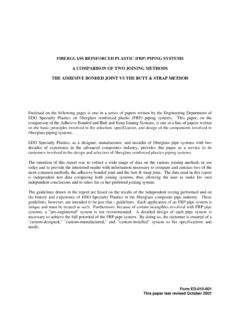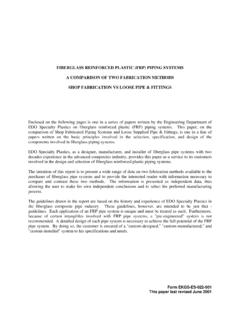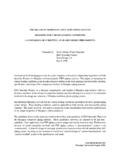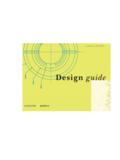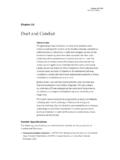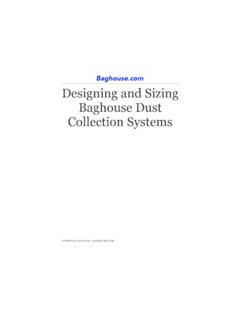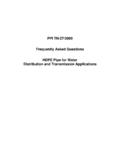Transcription of FIBERGLASS REINFORCED PLASTIC (FRP) PIPING …
1 FIBERGLASS REINFORCED PLASTIC (FRP) PIPING SYSTEMS. designing PROCESS / FACILITIES PIPING SYSTEMS WITH FRP. A COMPARISON TO TRADITIONAL METALLIC MATERIALS. Prepared by: Kevin Schmit, Project Engineer Specialty plastics , Inc. Baton Rouge, LA. May 29, 1998. Enclosed on the following pages is one in a series of papers written by the Engineering Department of Specialty plastics , Inc. on FIBERGLASS REINFORCED PLASTIC (FRP) PIPING systems. This paper, on designing process and facilities PIPING systems with FRP, is one in a line of papers written on the basic principles involved in the selection, specification, and design of the components involved in FIBERGLASS PIPING systems. Specialty plastics , Inc., as a designer, manufacturer, and installer of FIBERGLASS pipe systems with two decades experience in the advanced composites industry, provides this paper as a service to its customers involved in the design and selection of FIBERGLASS REINFORCED PLASTIC PIPING systems.
2 The intention of this paper is to present common design principles encountered when engineering a FIBERGLASS PIPING system. The approach, however, is slightly different, in that the design principles are presented by comparing them to traditional metallic materials. By doing so, the designer who is familiar with these metallic materials can hopefully better understand the unique design considerations of FIBERGLASS PIPING . The guidelines drawn in the report are based on the history and experience of Specialty plastics in the FIBERGLASS composite PIPING industry. These guidelines, however, are intended to be just that - guidelines. Each application of an FRP PIPING system is unique and must be treated as such. Furthermore, because of certain intangibles involved with FRP PIPING systems, a "pre-engineered" system is not recommended.
3 A detailed design of each pipe system is necessary to achieve the full potential of the FRP PIPING system. By doing so, the customer is ensured of a "custom-designed," "custom-manufactured," and "custom-installed" system to his specifications and needs. Form EKGS-ES-042-001. This paper last revised June 1998. 1 Introduction: One of the obstacles that FRP ( FIBERGLASS REINFORCED PLASTIC ) sometimes has to overcome is proper design of the materials. FRP has unique properties that, if disregarded, can lead to failure during operation. However, when these same unique properties are taken advantage of, they can provide the user with a system superior to traditional metallic materials. This paper discusses some of the basic principles in designing process and facilities PIPING systems with FRP. Since many users are more familiar with traditional metallic materials, this papers presents those basic principles by comparing the performance of FRP to carbon steels, stainless steels, titanium, and copper-nickel PIPING .
4 2 A Comparison of the Materials General There are many general differences between FRP and traditional metallic materials that have been established for many decades. While carbon steels, stainless steels, and copper-nickel are metals, isotropic, and homogenous, FRP is a composite, orthotropic, and heterogenous. Typical structural materials are normally divided into four basic categories: metals, polymers, ceramics, and composites. A composite is basically a combination of two or more other structural materials. FRP is a composite of a polymer (the resin) and a ceramic (the glass fibers). When we define composites in this manner, we are normally talking about composites formed on the macroscopic level. If we looked at it from the microscopic perspective, we would have to consider most materials to be composites.
5 By forming a composite such as FRP, an engineer can take advantage of the desirable properties of both constituent materials. In FRP, the glass fibers provide the strength and stiffness while the resin matrix acts as a binder providing impact resistance, compressive strength, and corrosion resistance. One property of FRP that results from it being a composite is it is non-isotropic whereas traditional metallic materials such as carbon steel are isotropic. When we say isotropic, we mean that the mechanical properties, such as strength and modulus, are the same regardless of direction. In a non- isotropic material, the properties associated with an axis passing through the material will depend on the direction it passes through the material. Thus, when you look up the mechanical properties of an FRP material, you will often find not one modulus value, but several modulus values, including axial tensile modulus, hoop tensile modulus, and axial compressive modulus.
6 It is extremely important when designing with composites such as FRP that the designer understands the non-isotropic properties of the material and takes this into account in the design process. Treating FRP as an isotropic material would be a poor assumption to make as a design engineer. 1 Rev: June 1998. A second property that results by forming a composite such as FRP is that the material is now heterogeneous. That is, its composition varies as you move from point to point through the material. Traditional metallic materials, on the other hand, are homogenous. To overcome this, most mechanical properties are averaged. This is achieved by treating the composite as an equivalent homogeneous material and averaging the properties of the constituent materials. In other words, instead of examining the composite on a micromechanical level, we eliminate the inhomogeneity by moving to the macromechanical level.
7 Thus mechanical properties such as axial tensile modulus are sometimes referred to as the effective axial tensile modulus. Design Temperature The temperature range of most FIBERGLASS REINFORCED plastics is much smaller compared to carbon steels, stainless steels, and copper nickel PIPING . Applications up to 150EF are common with FRP. and in some cases can reach as high as 300EF. This, however, is much lower than the temperature encountered with the traditional metallic materials. With these materials, design temperatures can reach 400EF without a considerable degradation in mechanical properties. In the case of stainless steel, the design temperature can reach up to 1100EF and still have an allowable stress above 10,000psi. 2 Rev: June 1998. Typical Temperature Limits of Process / Facilities PIPING Material Typical Temperature Limits FRP Most common applications are 150EF and below.
8 Some applications up to 250EF with a few special cases up to 300EF. Most resins will begin to degrade above 150EF at a rate of anywhere from 5% to less than 1% per 10EF rise. Some high temperature application resins will maintain 90% of their ambient temperature properties up to 250EF. ASTM A106 Grade B No reduction in properties: 400EF. Seamless 10% reduction in properties: 500EF. 20% reduction in properties: 700EF. ASTM A312 TP316L No reduction in properties: 300EF. 10% reduction in properties: 400EF. 20% reduction in properties: 600EF. Gr 2 Titanium No reduction in properties: 200EF. 10% reduction in properties: 200EF. 20% reduction in properties: Up to 200EF. ASTM B466 90/10 Cu-Ni No reduction in properties: 100EF. 10% reduction in properties: 300EF. 20% reduction in properties: Up to 550EF.
9 ASTM B467 70/30 Cu-Ni No reduction in properties: Up to 100EF. 10% reduction in properties: Up to 300EF. 20% reduction in properties: Up to 600EF. Source: FRP data is from numerous FIBERGLASS manufacturers. All other data is from ASME. Design Stresses As with design temperature, there is a significant difference between typical allowable stresses in FRP. and traditional metallic materials. As the table in this section shows, even for some copper-nickel PIPING , a typical allowable stress in tension is 9,500 psi at 200EF. With FIBERGLASS , design stresses will vary depending on the type of stress. When designing based on short-term hoop strength against internal pressure, the design stress may vary from 1,500 psi to 3,000 psi. For interlaminar shear strength, the design stress may be as low as 100 psi.
10 For intermittent loads, the design stress may reach as high as 4,000 psi, however, design stresses above 3,000 psi are rare. 3 Rev: June 1998. Typical Design Stresses Material Typical Design Stresses FRP Typically 1,000 - 4,000 psi The value varies depending on the type of stress, design life, and other variables ASTM A106 Grade B 20,000 psi at 200EF. Seamless ASTM A312 TP316L 16,700 psi at 200EF. Gr 2 Titanium 16,700 psi at 200EF. ASTM B466 90/10 Cu-Ni 8,300 psi at 200EF. ASTM B467 70/30 Cu-Ni 9,500 psi at 200EF. Source: FRP data is from numerous FIBERGLASS manufacturers. All other data is from ASME. Design Pressure (Typical Sizes are 2" - 12"). Another design variable that differs greatly is the design pressure. Most FRP process PIPING is used in 150# systems where the pressures are 200psig or lower.
